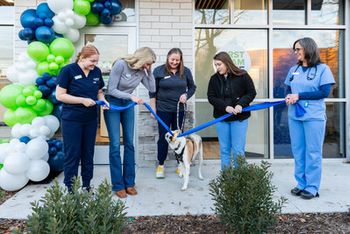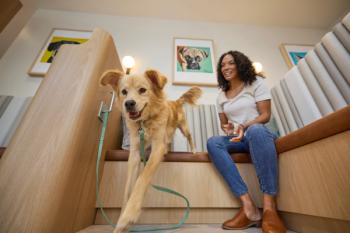
Charm by the seashore
When he moved his practice from the converted home it had occupied for 42 years, Dr. Rickey Broussard wanted to maintain the comfortable feel of the practice by building a facility that resembled Grandma's house. And judges of Veterinary Economics' 2001 Hospital Design competition agree that the homey front porch with brick accents gives the facility's dramatic entrance and lofty ceilings the warm appeal Dr. Broussard strived for.
By Carolyn Chapman,
special assignments editor
When he moved his practice from the converted home it had occupied for 42 years, Dr. Rickey Broussard wanted to maintain the comfortable feel of the practice by building a facility that resembled Grandma's house. And judges of Veterinary Economics' 2001 Hospital Design competition agree that the homey front porch with brick accents gives the facility's dramatic entrance and lofty ceilings the warm appeal Dr. Broussard strived for.
Dr. Broussard's homespun hospital, Ingleside Animal Hospital, located in the booming Navy town of Ingleside, Texas, garnered a Merit Award from the competition judges. The group praised the efficient, one-wall exam rooms and the inviting, home-like exterior, applauding Dr. Broussard's efforts to save the old oak trees.
Thinking ahead
Dr. Broussard, a 1988 Louisiana State graduate, came to Texas as an associate in a Lubbock practice. A few years later, he was anxious to strike out on his own, so he scoured journals looking for practices for sale. A tiny hospital in Ingleside on the north end of Corpus Christi Bay fell within his budget. And when he visited the facility, he understood why. "The practice operated out of a tiny, 1,000-square-foot house," Dr. Broussard says.
The original owner opened the practice in 1958 to serve a large animal clientele, but over the years it had evolved into a small animal hospital. The cramped quarters were enough to accommodate a farm-call operation but not a thriving small animal practice. Even so, Dr. Broussard saw a chance to implement his vision of veterinary medicine. "The practice was a gold mine," he says.
He purchased the practice in 1993, and three months later Dr. Broussard bought a 1-acre plot one block away for a new facility. He sat on the property for six years before breaking ground. As a stop-gap measure, he remodeled the house, converting an office into a second exam room.
Still, Dr. Broussard knew he needed to build to keep his practice growing and to accommodate clientele from a new military base that doubled the local population. So he approached a lender that helped him obtain Small Business Administration financing. "The paperwork was surprisingly difficult," he says. Dr. Broussard says he would have lost heart without the bank representative pushing him to meet deadlines. "She held my hand and we plowed through the process together," he says.
Next Dr. Broussard approached veterinary architect Ralph Thibodeau, based in Austin, Texas, to fine-tune his ideas for the new facility. Thibodeau asked Dr. Broussard and his wife, Cindy, to complete a questionnaire that outlined their project goals, budget, and more, then he began drawing the plans. Four drafts later, Thibodeau finalized Dr. Broussard's vision.
Thibodeau says he enjoyed working with the beautiful site in a growing area. "Of course, I was also pleased that the Broussards let me be the architect," Thibodeau says.
The five-hour drive between Austin and Ingleside prohibited Thibodeau from inspecting the project weekly, which concerned Dr. Broussard at first. But hiring Shirley Brothers contracting, a local contract manager, helped allay Dr. Broussard's fears. "Reputation is everything in a small town," he says. "So I was pretty sure they'd do their best for me. And in the end the company exceeded my expectations by installing high-end crown molding at no cost."
Grandma vs. glitz
Before committing his dream to paper, Dr. Broussard polled his growing client base to determine what features they wanted in a new hospital. Overwhelmingly, they wanted to preserve the old hospital's feel, with its established trees and homey atmosphere. That's why Dr. Broussard opted for the Louisiana antebellum look, with an expansive roof and a spacious front porch.
He cut down only five small trees during construction, preserving 60 100-year-old oaks, some with 3-foot-wide trunks. The trees tower around the exterior, a mix of red brick and "Hardie" concrete plank siding that mimics wood. A wraparound porch with brick accents and three dormer windows help the facility make a warm, inviting first impression.
When clients enter through the multi-paned double doors, soothing music greets them. "I want clients to feel like they're entering a home, so we worked hard to develop a comfortable environment that's not harsh or sterile," Dr. Broussard says.
Inside, the walls and reception desk feature varnished beaded-maple wainscoting, and forest-green countertops complement the red-plaid wallpaper used to accent one wall of the reception area. Cindy Broussard chose to use durable, easy-to-clean ceramic tile flooring throughout most of the practice, except in Dr. Broussard's office, which features polyurethane-finished hardwood flooring, and the kennel, which has a nonslip epoxy-paint finish. Grooming sits off the dog waiting area, and windows help draw attention to the ancillary service.
In a salute to the past, Cindy Broussard also purchased several antique cabinets to showcase old veterinary equipment and war relics. Dr. Broussard remembers the original owner, Dr. Jack Hableutzel, by posting his stethoscope and diploma. Framed artwork, such as an old edition of Puss-N-Boots and documents detailing how farm animals aided the World War II effort, line the treatment walls.
The exam rooms mirror the themes established in the reception area, with green backsplashes and countertops, benches, and wood cabinetry. And in the pharmacy and treatment areas the woodwork is stained green and the countertops are tan.
A pass-through between the lab and treatment areas eliminates steps, and the treatment area features a dedicated doctors' station with shelves above for storage. Behind this station sits isolation, with its separate ventilation system to prevent cross contamination.
Preferring a quiet operating environment, Dr. Broussard situated the surgery, pack/prep, and radiograph areas in the southwest corner, as far from the kennels as possible. The doctors' office and staff lounge, which sit next to surgery, are clustered together to improve communication.
Four heating and cooling zones keep the hospital comfortable and ventilated. Dr. Broussard chose ductwork that runs through externally insulated sheet metal for maximum odor control and ease of cleaning.
Know the specs
For those planning building projects, Dr. Broussard offers this advice: Know you plan thoroughly. "Ask your architect to walk you through every room and every wall of every room," he suggests. Even following this strategy, he says, he experienced some unforeseen complications. For example, Dr. Broussard planned to place a coffee urn on the south wall of reception only to discover there wasn't an outlet along the wall. A costly change order solved the problem. In his office, the bookshelf to house his computer has no hook up; luckily, he chose a wireless system. "Know where every outlet, light switch, and phone jack will be," he advises. "Envision yourself practicing in each room so you won't have as many surprises when you move in."
Dr. Broussard reflects that his goal with the new facility was to provide sound care in an upscale environment without desecrating nature. "When I drive up to the practice and go inside, I know I've made the right choices to achieve all of those goals," he says.
Carolyn Chapman, a former Veterinary Economics associate editor, is a freelance writer in Liberty, Mo.
Newsletter
From exam room tips to practice management insights, get trusted veterinary news delivered straight to your inbox—subscribe to dvm360.




